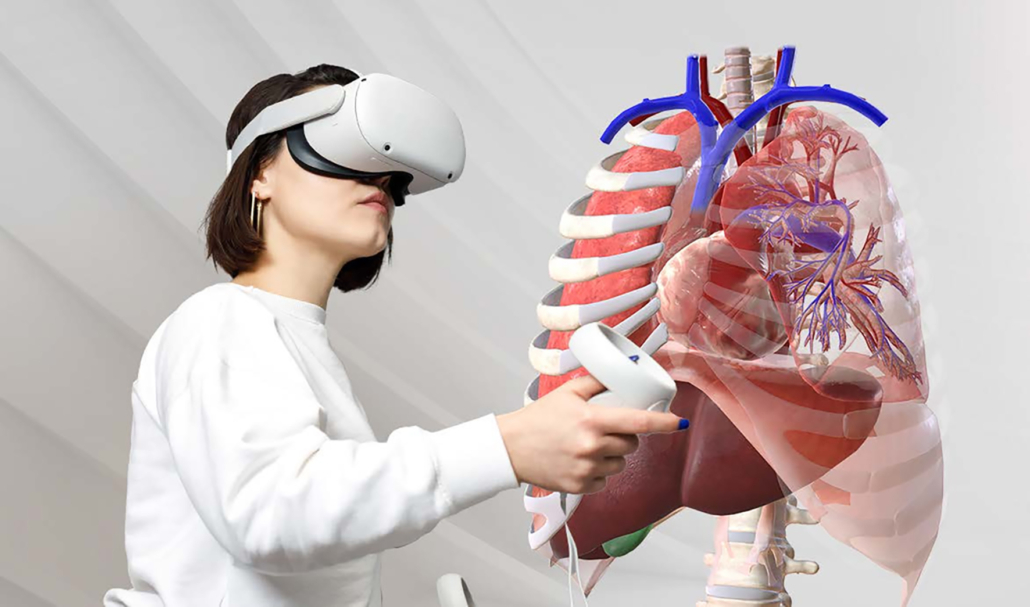Students enter the metaverse as Wolters Kluwer & BioDigital launch extended reality anatomy
Wolters Kluwer, Health, a leading global provider of information and point of care solutions for the healthcare industry has announced the integration of BioDigital XR with Wolters Kluwer Medical Education & Medical Practice expansion. This collaboration will bring extended reality (XR) based medical education solutions to students across the healthcare landscape to enhance their curriculum, providing an immersive learning environment with both virtual reality (VR) and augmented reality (AR) solutions.
As higher education institutions continue to look for ways to keep up with the expectations of the next generation of students while preparing them for the real world, the digital transformation of medical education has been a major shift. Medical schools, healthcare programmes, and residency and trainee programmes are increasingly using AR and VR technology as a cost-effective complement to traditional training methods. Virtual reality provides students with an immersive learning experience that allows them to manipulate anatomical structures and better understand the spatial relationships in the human body.
“The adoption of virtual reality technologies in the classroom, along with solutions in the metaverse, will help future clinicians access valuable, high-fidelity experiences before they enter the workforce,” said Vikram Savkar, Senior Vice President & General Manager, Medicine Segment, Health Learning, Research & Practice at Wolters Kluwer. “While nothing can replace hands-on experience, these technologies can be a strong bridge between classroom teachings and experiential learning.”
Designed for any educational programme with an anatomy component – medical, nursing, physical therapy, occupational therapy, or sports medicine – BioDigital XR provides an intuitive, active learning solution that students can access wherever and whenever they want. This collaboration will combine BioDigital XR with the world’s most trusted line-up of anatomy content through the Lippincott portfolio, including Moore’s Clinical Oriented Anatomy, Grant’s Dissector, Acland’s Anatomy, and more.
“We are excited to expand our collaboration with Wolters Kluwer by adding BioDigital XR to the Lippincott portfolio. With BioDigital XR and the BioDigital Human, schools and hospitals around the world will be able to access the most comprehensive cloud-based model of the human body ever assembled in virtual reality in addition to on mobile and desktop devices – another leap forward in improving the way people understand health and the human body,” said Frank Sculli, CEO at BioDigital.
Wolters Kluwer and BioDigital will be showcasing the latest innovations in virtual reality at the upcoming International Meeting on Simulation in Healthcare (IMSH) held January 21-25, 2023, in Orlando, Florida.
BioDigital Human
This news builds upon the addition of BioDigital’s 3D virtual body platform to Ovid for an immersive teaching and learning experience that was announced earlier this year. The BioDigital Human, a medically accurate virtual map of the human body, was developed for an immersive teaching and learning experience. With advanced integration capabilities, the cloud-based software platform is accessible anywhere, on any device, to gain a deeper understanding of the body’s anatomy and explore disease evaluation, progression, and treatment in interactive 3D.
For faculty, BioDigital Human offers a powerful but intuitive authoring toolkit and assessment builder, making it simple to customize models to meet learning objectives and embed them directly into curriculum, streamlining learning inside and outside of the classroom.
“The pandemic accelerated adoption of blended learning curricula and showed that adapting even the most hands-on topics like anatomy to a virtual world is possible with the right tools,” said Savkar.
Hailed as “Google Maps for the Human Body,” the BioDigital Human platform includes comprehensive, medically accurate anatomy with over 8,000 individually selectable anatomical structures, 600 simulated health conditions and treatments in interactive 3D, a powerful authoring tool and assessment builder, as well as a toolkit to map and visualize data.
Sculli commented: “Over the last few years, we’ve seen the immersive content powered by our cloud-based platform transform the learning experience for organizations across health and medicine.”
NEJM Group partner with Wolters Kluwer to expand global reach of leading journals
In November, Wolters Kluwer Health and NEJM Group entered into an exclusive partnership to ensure that more researchers and clinicians around the world can access the growing family of NEJM Group journals. Building on years of collaboration, this expanded partnership positions NEJM Group journals for sustained global growth through Wolters Kluwer’s Ovid medical research platform. Publications currently included are the New England Journal of Medicine, NEJM Evidence, NEJM Catalyst Innovations in Care Delivery, NEJM Journal Watch and the NEJM Archive. Future NEJM Group journals will be added.
Through the partnership, institutional online subscribers to NEJM Group journals will be able to access their subscriber content both on NEJM Group sites and on the Ovid medical research platform. Spanning over 150 publishers and more than 100 specialty areas, Ovid serves as the powerful, one-stop research software to help researchers, librarians, clinicians, and other healthcare professionals find timely and relevant medical information to make critical decisions to improve patient care, enhance ongoing research, and fuel new


